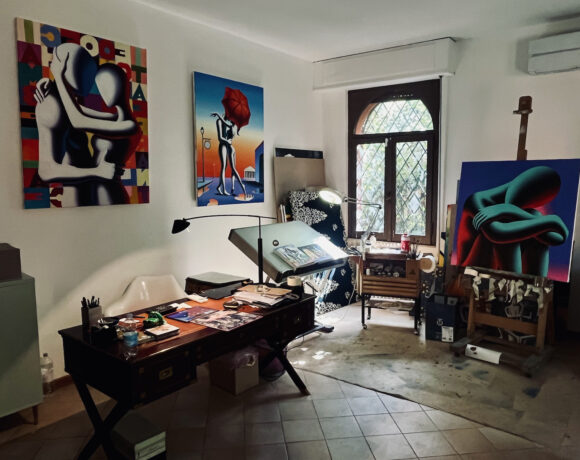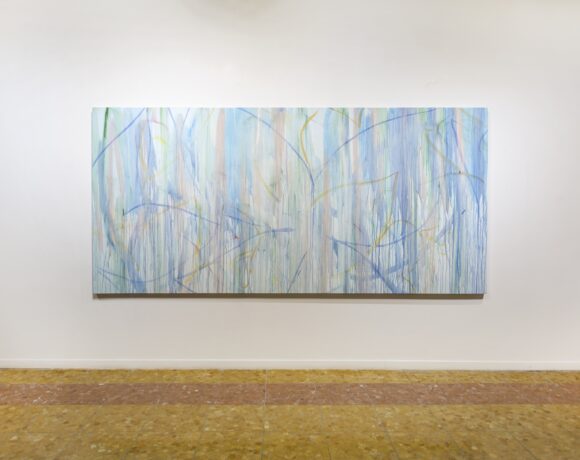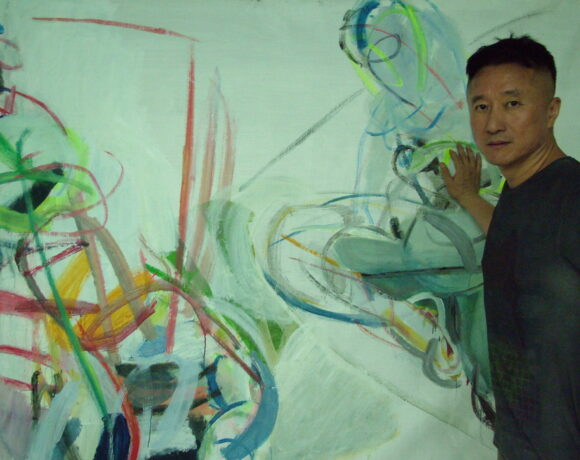How important is time in your artistic process, from the concept to the realisation of the painting?
Colm MacAthlaoich: Either I don’t have enough of it or I don’t manage it well but I sometimes find it difficult to predict when my paintings are finished due to the transformative way I work. Process plays a central part to the way I work, as in the painting process itself relies as much on control as on chance. A painting will have many possible outcomes and time often determines when it’s finished, depending if I have enough of it or I’m running out of it.
How do you consider your art practice? And how do you describe it?
I am a painter principally, with a background in Printmaking and design. Although my approach to painting is formal and could be considered traditional, my process is experimental and involves a subconscious automatism. My work touches on themes concerned with the human condition, history and social cultures among others.
What means the title The Waiting Game?
Taking the title The Waiting Game I reference the Irish playwright Samuel Beckett’s 1953 play Waiting for Godot, in which two characters wait for the arrival of someone named Godot who never arrives, and while waiting they engage in a variety of discussions and meet a number of characters. The structure of the play is loose and free, and in many ways very elemental, it invites all kinds of social and political and religious interpretations. While it has been said Beckett’s play is a metaphor for the futility of man’s existence, the playright himself saw it as a game, everything is a game everything becomes an imitation, an imitation of reality. I am also curious of how my interpretations of social and political topics are viewed from the vantage point of an Irish hetero male living in Spain. The outcome was a series of works that look at apposing gender norms, cultural tropes and traditions which came about from my experience in living in Spain. I use a transitive approach to painting, over lapping, over painting, re-painting, adding and removing elements as the composition evolves as my emotive response to these topics.
Which emotions do you try or not to arouse in the observer?
There are two things at play when looking at a painting, there is the immediate emotional interpretation based on aesthetic evaluation by the individual, secondly there is the conceptual interpretation, which can shape our understanding of the work, thus overturning an aesthetical connection, giving way to a new meaning of the work. I like to play with both these ways of seeing, using the traditional techniques of composition, colour and form to establish an aesthetic reaction while presenting the subject matter in the form of a figure in space. I also use single figures in this series so as to direct a focus on the individual, the subject of my research. I want the viewer to connect with this individual, to engage with their position, to evaluate and ultimately to respond emotionally to him, her or it.
Your art changed after your residency in Spain. How much does your everyday life experience influences your art, your painting methods and subjects?
Authenticity is essential to my work process, almost to a gonzo journalistic level. I’m driven by the direct experience and believe for me that this is the only way I can achieve an authentic experience, which I want to express through my work. Before I moved to Spain I was concerned with the idea of the thought and place, I also looked at repetitive motifs and pattern, this was more to do with developing a voice and simplifying my work to its basic elements. As soon as I moved, my environment changed dramatically and my response to my new surroundings came instantly. For me the idea of cultural appropriation is better served when lived through. In my painting, the battle of what to say and what not became a new challenge, and in the past year I have been developing a way to subdue and translate these emotive reactions in my work.
 Colm MacAthlaoich, Cluiche fanachta (The waiting game), 2018. Oil on canvas, 130 x 97 cm
Colm MacAthlaoich, Cluiche fanachta (The waiting game), 2018. Oil on canvas, 130 x 97 cm
 Colm MacAthlaoich, An tríú fear (El Tercio), 2018. Oil on canvas, 81 x 73 cm
Colm MacAthlaoich, An tríú fear (El Tercio), 2018. Oil on canvas, 81 x 73 cm

is art historian, critic and independent curator based in Turin and Dublin (Ireland).







NO COMMENT